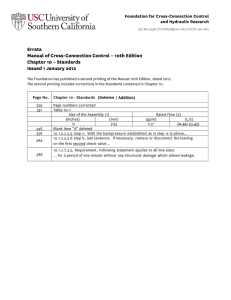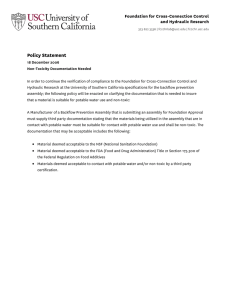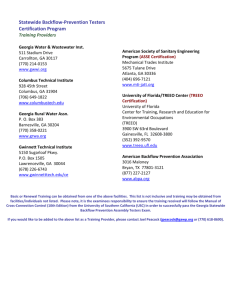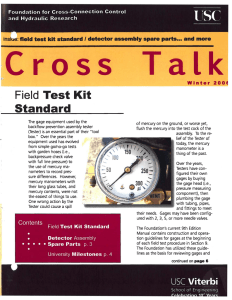Tenth Edition of the Today, various building codes are requir-
advertisement
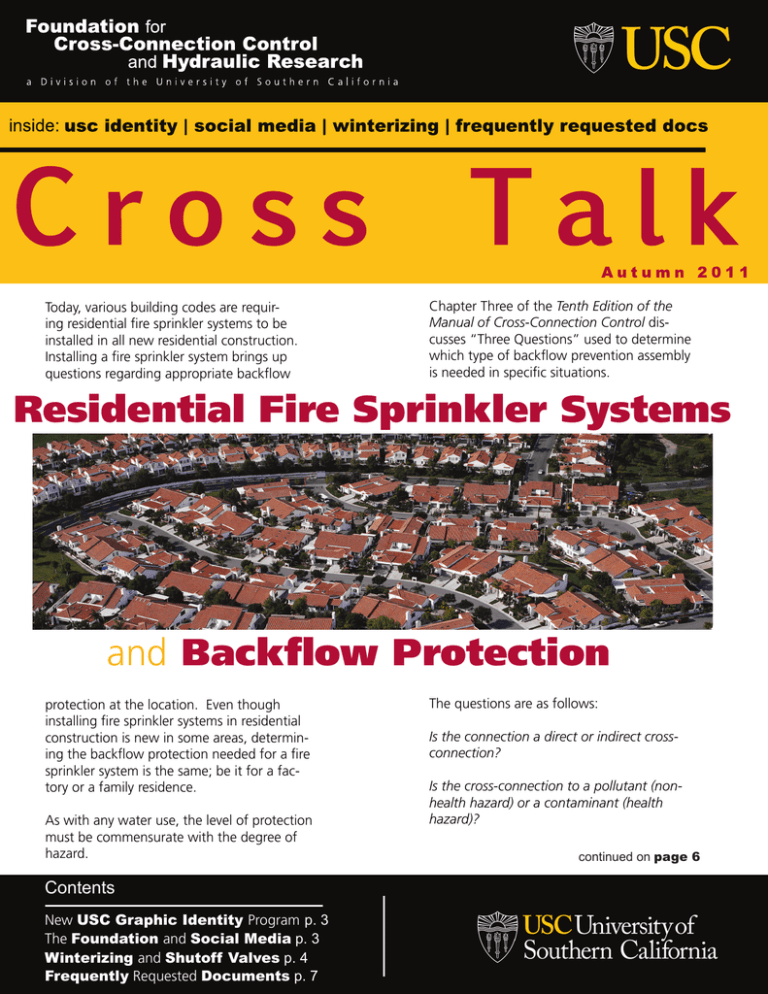
Today, various building codes are requiring residential fire sprinkler systems to be installed in all new residential construction. Installing a fire sprinkler system brings up questions regarding appropriate backflow Chapter Three of the Tenth Edition of the Manual of Cross-Connection Control discusses “Three Questions” used to determine which type of backflow prevention assembly is needed in specific situations. Residential Fire Sprinkler Systems and Backflow Protection protection at the location. Even though installing fire sprinkler systems in residential construction is new in some areas, determining the backflow protection needed for a fire sprinkler system is the same; be it for a factory or a family residence. As with any water use, the level of protection must be commensurate with the degree of hazard. Contents New USC Graphic Identity Program p. 3 The Foundation and Social Media p. 3 Winterizing and Shutoff Valves p. 4 Frequently Requested Documents p. 7 The questions are as follows: Is the connection a direct or indirect crossconnection? Is the cross-connection to a pollutant (nonhealth hazard) or a contaminant (health hazard)? continued on page 6 Foundation Membership The Foundation’s Membership Program provides many benefits to the Members of the Foundation. These include: a twenty-five percent discount on manuals, twenty percent discount on Foundation Training Courses for any employee of the Member company/organization, the List of Approved Backflow Prevention Assemblies with access to the up-to-the-minute version on the Foundation’s website. Members are encouraged to call the Foundation with technical questions. The Foundation’s Engineering Staff is available to assist Members with the various aspects of field testing backflow preventers, installing backflow preventers and administering their cross-connection control program. Below is a list of those who have become members of the Foundation since the last Cross Talk: AAA Precision Backflow, LLC JW Fire Sprinkler Design Aaron Old Lynwood City Hall ABPA- Central Coast Chapter Nibco Accurate Backflow Services Peterson Plumbing Co. Anmac Service Company Pipeman Plumbing Capstone Mechanical Pride Industries Clean Water Services Serian Company, Inc. Costich Engineering Seward, City of - Public Works Dept. Cuesta College Steve Chew Florida Section AWWA Thomas Plumbing Company Garden Grove, City of UC Davis WSREC High Tech Construction & Fire Protection Val-Matic Corp. Hollister, City of Washington Suburban Sanitary Commission Joe Green Plumbing Williams, City of Cross Talk is published by the Foundation for Cross-Connection Control and Hydraulic Research, a division of the University of Southern California, for Foundation Members. 2011 © University of Southern California. All rights reserved. Page 2 AUTUMN 2011 Cross Talk New USC Graphic Identity Program In the coming months Foundation members will notice a new logo for the University of Southern California. Beginning on November 1, USC began a rollout of its new graphic identity program designed to reflect USC’s position as a premier institution in education. The new graphic identity program consists of a new USC logo, monogram and typefaces. The shield, which has been part of the University Seal since 1908, twenty-eight years after the University’s founding in 1880, is a major part of the new identity. The shield bears a setting sun and three torches. The sun signifies the West and, according to tradition, power and life. The three torches represent learning in the arts, sciences and philosophy. The shield will be featured prominently throughout USC’s new graphic identity program. Introducing a new logo will help USC maintain a consistent look throughout all different schools and departments names within the University. Over the next year USC will be phasing in the new identity program. The new logo will be featured in the new Field Testing Backflow Preventers Instructional Video coming out at the beginning of 2012. Foundation Members may still see some of the elements from the previous identity program until the phasing in of the new system is final. g The Foundation and Social Media The USC Foundation recently set up a Facebook and Twitter account. The past couple of years has seen social media, like Facebook, skyrocket in the number of users and in the process has created a new means of communication. The Foundation will use social media tools, like Facebook, as another means of communicating information with its members. Information regarding List updates, Cross Talk topics, course dates and much more will be posted. Bear in mind, the Foundation will continue updating its website (fccchr. usc.edu) and notifying members of any changes to the List via e-mail. A member’s e-mail contact will continue to be the Foundation’s primary form of contact regarding any List updates. All members are encourage to follow the Foundation on Facebook, Twitter and the website for news on the upcoming release of the new Field Testing Backflow Preventers Instructional Video being released early next year. All information regarding the Foundation’s social media contact may be found on the back page of Cross Talk. g Cross Talk AUTUMN 2011 Page 3 Winterizing and Shutoff Valves With winter fast approaching many will be winterizing portions of their water systems. Winterizing involves the water being drained out of the water line prior to the winter months to prevent pipes from bursting. This type of damage may be found on water pipes and backflow prevention assemblies. A number of approved backflow prevention assemblies use fully ported ball valves in their assemblies that may increase the likelihood of damage due to freezing on those shutoff valves during the winter months unless proper precautions are taken. The use of resilient seated shutoff valves in approved backflow prevention assemblies has significantly improved the field-testing of the assemblies. Having a tight shutoff valve has made the job of the field tester considerably easier. Most manufacturers of the 2” and the smaller variety have selected to use fully ported ball valves as their type of resilient seated shutoff valves. These valves have shown themselves to be effective due to the flow characteristics and its effective shut off capabilities. However, they have shown to be damaged during the colder Page 4 AUTUMN 2011 months unless precautions are taken to prevent damage due Below you can see where the trapped w to freezing. Top View When water freezes Opened it occupies a 9% greater volume than in its liquid form. The ice causes pressure to build Flow inside the pipes that can cause them to burst and may cause permanent damage in shutoff valves that are a part of backflow Below you can see where the trapped wa prevention assemblies. WinterTop View izing a water system Closed helps but it may not completely eliminate the possibility of the shutoff valves being damaged during the Flow colder months. Even with the winterizing of a water line, the ball valves may be left in the fully opened or fully closed position. When A valve left at a 45-degree angle will all this is done there result reducing may be a small Top View volume of water Closed trapped between the outside of the ball and the body. With this trapped volume of water freezing, the resulting damage can Flow be significant. Seals or components may be distorted and in extreme cases the body housing itself could be cracked. As seen in the figure, with the valve in the opened or closed position, the small pocket of water is trapped in place. Cross Talk water would collect if a valve is left open. Where winterizing of a water line is necessary, it is highly recommended that the ball valve be left in a partially opened position. Leaving the valve at a 45-degree angle will leave this pocket unsealed and the trapping of water will be significantly reduced, thus eliminating any damage to the valve. Ideally, backflow preventers used in environments with freezing temperatures should be kept in an area (i.e., building, basement) protected from the harsh environment. However, this is not always possible or practical. For those Trapped Water backflow prevention assemblies that are on water lines that must operate during winter months; enclosures can be used to protect the assemblies from freezing. Enclosures may generally be separated into two categories; freeze retardant enclosures (i.e., non-heated) and freeze protection enclosures (i.e., heated). However, the above-mentioned suggestions may not always be available and therefore in those cases it is important to leave the ball valves in the partially open position in order to minimize the potential for trapping water in the ball valve and that should help prevent freeze damage to ball ater would collect if a valve is left closed. valves. g Orientation of Assemblies Trapped Water The USC Foundation’s policy is that assemblies are approved for installation in the orientation under which they were evaluated only. Installing an assembly in any other orientation other than the orientation(s) listed on the List of Approved Backflow Prevention Assemblies will invalidate the USC Foundation’s Approval. Depending upon the type of assembly, there are several orientation possibilities. low water to escape from the pockets as a g risk of damage. Water Escapes Some have commented that the USC Foundation does not approve assemblies in certain orientations. On the contrary, the USC Foundation will approve an assembly in any orientation as long as the manufacturer requests it and the assembly successfully completes both the laboratory and field evaluation. Please refer to the List for orientation information along and orientation key attached to the List. g Cross Talk AUTUMN 2011 Page 5 fire sprinkler systems: continued continued from page 1 Is the connection under continuous use or pressure (used for more than twelve of any twenty-four hours)? systems may create a backpressure condition due to elevation, thermal expansion etc. Jumping ahead to question three Is the connection under continuous use or pressure (used for more than twelve of any twenty-four hours)? By answering these three questions and referencing the chart on page 58 of the Tenth Edition one can determine which type of backflow prevention assembly is required for backflow protection. The systems are considered under continuous pressure. The chart is shown here. And, finally question number two Is the cross-connection to a pollutant or contaminant? TYPES OF BACKFLOW PROTECTION Direct Indirect Backsiphonage & Backpressure Backsiphonage Only Health Hazard (Contaminant) PVB/SVB Non-Health Hazard (Pollutant) Continuous Use PVB/SVB RP AIR GAP RP DC AIR GAP Non- Continuous Use AVB RP PVB/SVB RP AIR GAP AVB PVB/SVB DC RP AIR GAP Applying the three questions above, the following is discovered. Is the connection a direct cross-connection (subject to back pressure) or is it an indirect cross-connection? Any fire sprinkler system will be considered a direct cross-connection because sprinkler This isn’t always a simple question. In situations where there are additives in the sprinkler system, such as fire fighting foams for fighting chemical fires, or anti-freeze to prevent freezing, the degree of hazard will be considered a health hazard. But there is another condition to consider. In fire sprinkler systems there if often a problem because of water sitting AIR GAP stagnant in the pipeline for a period of time. The Water Research Foundation (formerly the American Water Works Association Research Foundation) sponsored a study (90752) in DC 1998 testing the quality of water in wet-pipe fire sprinkler systems. This RP study found that water quality exceeded secondary standards for iron, AIR GAP manganese, TDS, color and odor; as well as the primary standards for lead and cadmium. This is the piping used in most fire sprinkler systems and is not considered potable piping material for the obvious reasons. Some agencies have required reduced pressure principle assemblies on all black iron piping systems because of this report. If the piping is considered potable piping, the problem of the stagnant water is still an issue. In these cases, however, the degree of hazard would be considered a pollutant, or noncontinued on page 7 Page 6 AUTUMN 2011 Cross Talk health hazard. A pollutant is considered something that is aesthetically objectionable. It may smell, look and/or taste bad but ingestion will not cause illness or death. In some cases residential fire sprinkler systems are using potable water piping on a flowthrough system. This means the water that is being used in the residence flows through the fire sprinkler system to get to the various points of water use. In this way the water never becomes stagnant in the pipes but is constantly being refreshed when any water is being used. In these situations there is no degree of hazard and no backflow protection would be needed. g Frequently Request Documents The USC Foundation’s website (fccchr.usc.edu) is a valuable resource for members; providing training tools, courses and information regarding backflow prevention and cross-connection control. One of the many features of the site includes a “Frequently Requested Documents” page that makes available information regarding several of the more popular subjects the Foundation receives questions about on a daily basis. The page may be found below the ‘Information’ pane on the USC Foundation’s website home page (http://www.usc.edu/dept/fccchr/frd.html). There, members can find some of the more important documents pertaining to backflow training and cross-connection control. Currently, members may find a worksheet entitled ‘Field Test Procedures 9th Edition vs. 10th Edition,’ that lists the differences between the field test procedures found in both editions of the manual side-by-side. With the release of the Tenth Edition two years ago many members were confused on the changes and what the reasons where for the change. The worksheet outlines the four backflow prevention assemblies (RP, DC, PVB, SVB) and lists the reasons for the change in the Tenth Edition. Another frequently requested document found on the page is entitled ‘Protection for Post Mix Carbonators,’ which address the common questions regarding the level of backflow protection needed on post mix soft drink carbonators. Other documents found on the “Frequently Requested Documents” page includes; Prevalence of Cross-Connections in Household Plumbing Systems, Gages and Manufactures and Hosting Course Information. The Foundation strongly recommends all members take a few minutes to look through some of the documents found on the “Frequently Requested Documents” page. g Cross Talk AUTUMN 2011 Page 7 Training Courses Tester Course Los Angeles, CA 9-13 January 2012 Specialist Course Los Angeles, CA 23-27 January 2012 Upcoming Events TREEO Center Annual Cross-Connection Control Conference Daytona Beach, FL 7-8 March 2012 CA/NV AWWA Spring 2012 Conference Santa Clara, CA 2-5 April 2012 ABPA Annual Education Conference & Trade Show Reno, Nevada 30 April - 2 May 2012 Social Media follow us at twitter.com/uscfccchr become a fan by clicking ‘Like’ on our facebook page facebook.com/uscfccchr Foundation for Cross-Connection Control and Hydraulic Research University of Southern California Kaprielian Hall 200 3620 South Vermont Avenue Los Angeles, California 90089-2531 Contact Information Phone: 866-545-6340 Fax: 213-740-8399 E-mail: fccchr@usc.edu Website: fccchr.usc.edu First Class US Postage PAID University of Southern California
